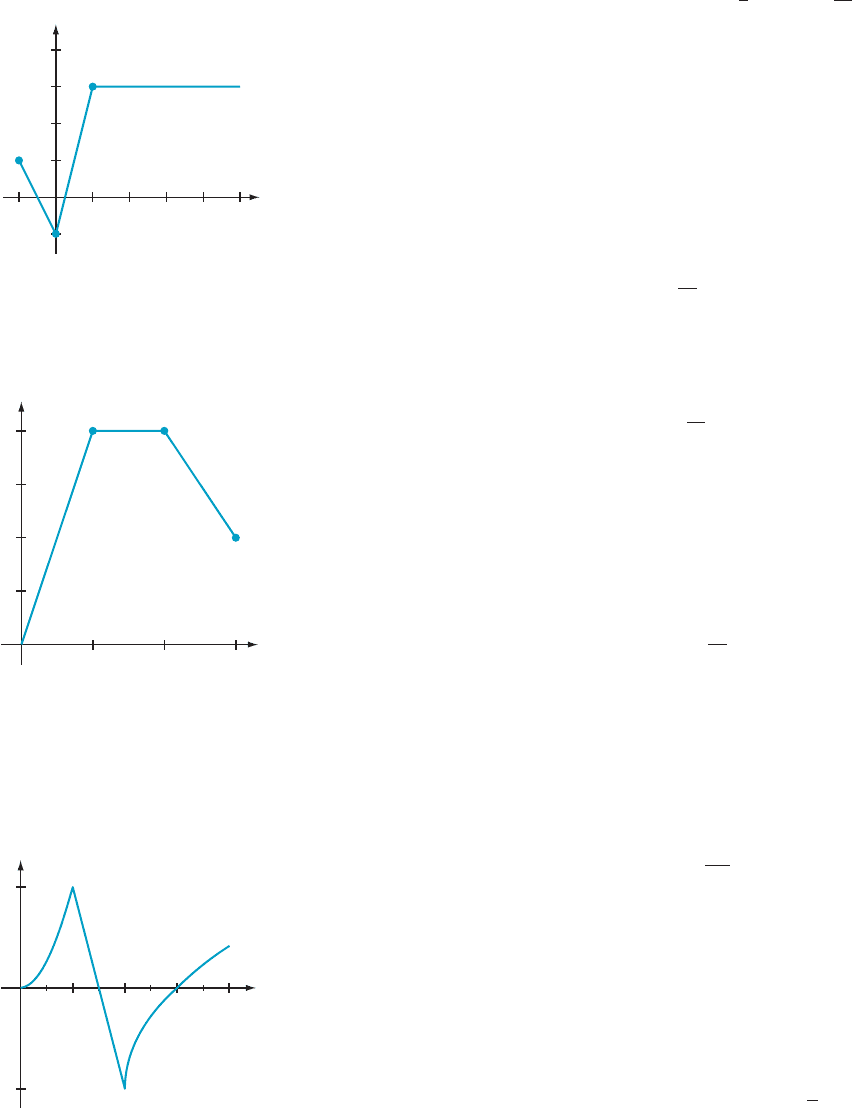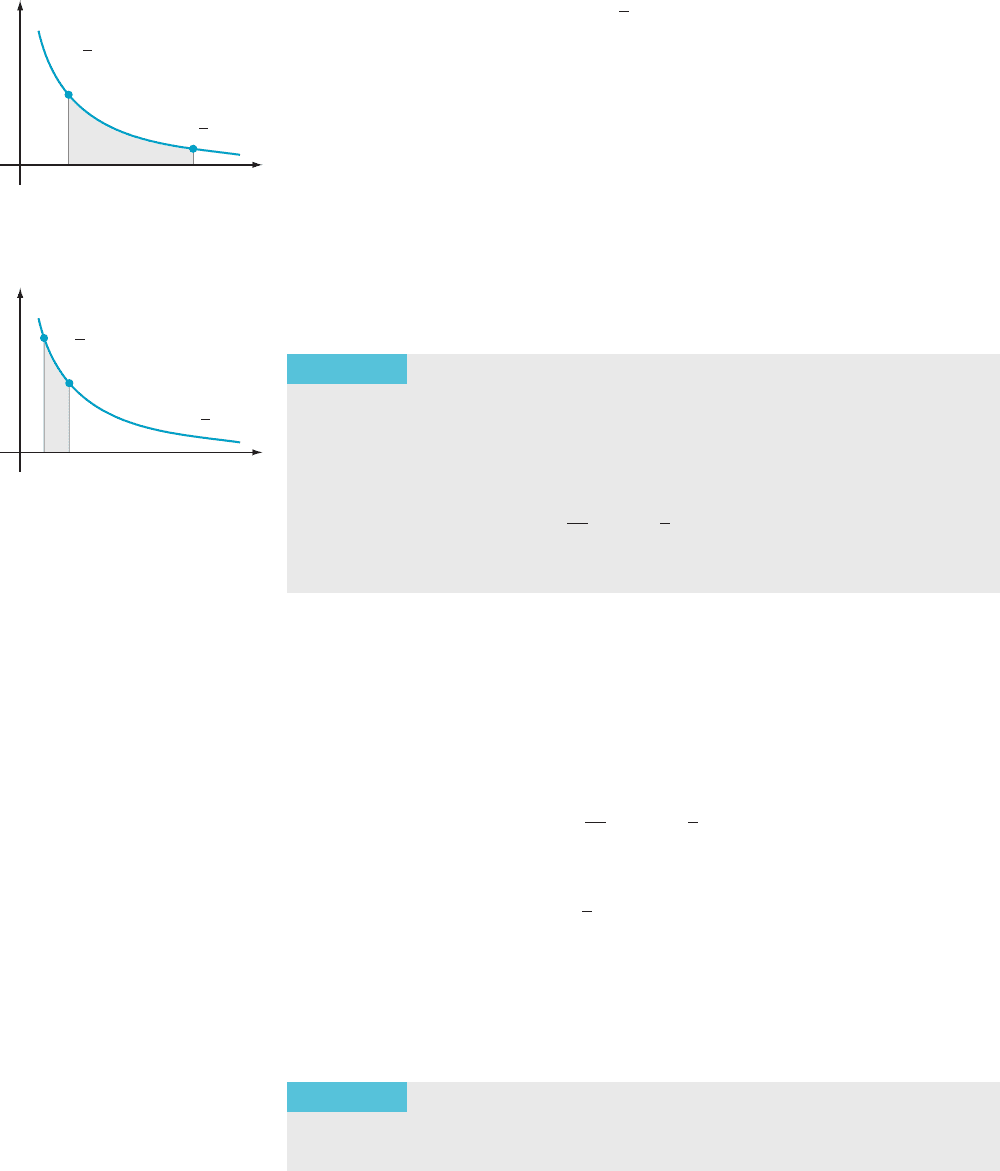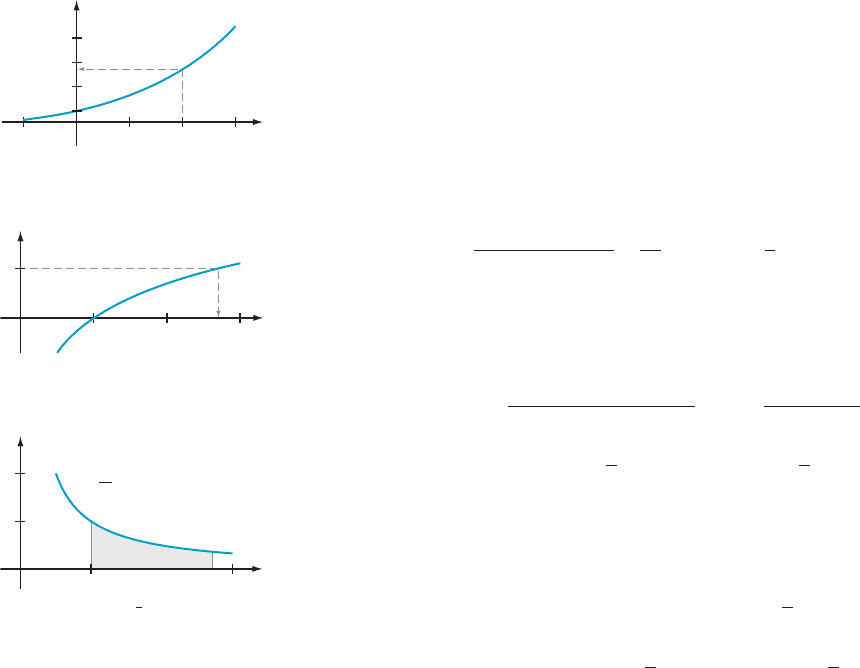Blank B.E., Krantz S.G. Calculus: Single Variable
Подождите немного. Документ загружается.


54. Calculate FðxÞ5
R
x
21
f ðtÞdt where f is the function with
the graph that appears in Figure 5.
55. Find a function f such that FðxÞ5
R
x
0
f ðtÞdt for the func-
tion F with the graph that appears in Figure 6.
56. For the function f shown in Figure 7, determine on what
interval(s) FðxÞ5
R
x
0
f ðtÞdt is increasing, decreasing,
concave up, and concave down.
57. Consider the integration
Z
2
22
t
24
dt 52
1
3
t
23
2
22
52
1
12
:
Integrating a positive function from left to right should
not result in a negative number. What error has led to the
incorrect negative answer?
58. The Fundamental Theorem of Calculus guarantees the
existence of a function F with a derivative of |x|. Write an
explicit formula for F. Your formula should contain no
integrals.
59. Let g and h be differentiable functions, and let f be a
continuous function. Suppose that the range of h is con-
tained in the domain of g. Find a formula for
d
dx
Z
gðhðxÞÞ
a
f ðtÞdt:
60. Let g and h be differentiable functions, and let f be a
continuous function. Use the method of Example 6 to find
a formula for
d
dx
Z
gðxÞ
hðxÞ
f ðtÞdt:
61. Suppose that f is a differentiable function with continuous
derivative f
0
. What is the average rate of change of the
function f over the interval [a, b]? (Refer to Section 3.1 in
Chapter 3, if necessary.) What is the average value of f
0
over [a, b]? (Refer to Section 5.3, if necessary.) Prove that
these two quantities are equal.
62.
GðaÞ5
d
dx
Z
x
a
f ðtÞdt
x5 0
:
What is G
0
(a)?
63. Suppose f and g are functions with continuous derivatives
on an interval containing [a, b]. Prove that if f (a) # g (a)
and if f
0
(x) # g
0
(x) for all x in [a, b], then f (x) # g (x) for
all x in [a, b].
64. In probability and statistics, the error function (erf) is
defined for x $ 0by
erfðxÞ5
2
ffiffiffi
π
p
Z
x
0
expð2t
2
Þdt:
Show that the graph of erf is concave down over [0, N).
65. Dawson’s integral is the function defined for x $ 0by
FðxÞ5 expð2x
2
Þ
Z
x
0
expðt
2
Þdt:
Compute F
0
(x).
66. The Fresnel sine integral, defined by
Fresnel SðxÞ5
Z
x
0
sin
π
2
t
2
dt;
4.03.02.0
y
f
t
1.0
1
1
m Figure 7
4
1
112
(0, 1)
(1, 1)
(1, 3)
f
t
y
345
2
3
m Figure 5
2.0
0.5
12
(1, 2) (2, 2)
(3, 1)
F
x
y
3
1.0
1.5
m Figure 6
5.4 The Fundamental Theorem of Calculus 415

is an important function in the theory of optical diffrac-
tion. Determine the intervals on which this function is
concave up.
67. The function
CðxÞ5
Z
x
0
t
4
ffiffiffiffiffiffiffiffiffiffiffiffi
1 1 t
2
p
dt ðx $ 0Þ
arises in the computation of pressure within a white
dwarf. Show that C is an increasing function with a graph
that is concave up.
68. The sine integral is the function Si, defined by Sið xÞ5
R
x
0
sinðtÞ=tdt: Calculate lim
x-0
SiðxÞ=x.
69. Let f be continuous on an interval I that contains a and b.
For x in I set FðxÞ5
R
x
a
f ðtÞdt and GðxÞ5
R
x
b
f ðtÞdt: Use
the Fundamental Theorem of Calculus to show that there
is a constant C such that F 5 G 1 C. Using Theorem 3
from Section 5.3 to give a second proof.
c Averaging data smooths it out. The Mean Value Theorem
for
Integrals tells us that for a fixed h, we can think of the
integral
A
f
ðxÞ5
1
2h
Z
x1h
x2h
f ðtÞdt
as an operation that averages the values of f over the interval
[x 2 h, x 1 h]. Figure 8 shows a plot of the price f of one share of
Microsoft’s stock at the close of ten consecutive trading days in
the summer of 2009. Figure 9 shows a plot of the average price
A
f
that is obtained by using h 5 1/4. (This choice of h is arbi-
trary.) In each of Exercises 70272,
calculate and plot A
f
over
[21, 1] for the given function f and h 5 1/2. b
70. f (x) 5 |x|
71. f ðxÞ5 f
0i
fx , 0
x if 0 # x
72. f (x) 5 signum(x)
73. Let f (x) 5 bx c be the greatest integer function. Show that
FðxÞ5
Z
x
0
f ðtÞdt
is not differentiable at x 5 1.
74. Let b be a constant, and set
f ðtÞ5
0ift , 0
x 1 b if 0 # t
:
Show that F (x) 5
R
x
21
f ðtÞdt is continuous at x 5 0 for all
values of b but differentiable at x 5 0 only if b 5 0.
Calculator/Computer Exercises
c In Exercises 75278, plot F
0
and F
00
. Determine the
intervals on which F is increasing, decreasing, concave up,
and concave down. b
75. FðxÞ5
R
x
23
ðt
3
2 3t
2
1 3t 1 4Þdt
76. f ðxÞ5
R
x
0
ðt 1 1Þ=ðt
4
1 1Þdt
77. FðxÞ5
R
x
0
ðt
3
2 tÞe
t
dt
78. FðxÞ5
R
x
1
ðt
2
2 3Þ lnðtÞdt x . 0
79. In a particular regional climate, the temperature varies
between 228
C and 46
C and averages 13
C. The number
of days N (T) in the year on which the temperature
remains below T degrees centigrade is given (approxi-
mately) by
NðTÞ5
Z
T
228
f ðxÞdx ð228 # T # 46Þ
where
f ðxÞ5 12:66 exp
2
ðx2 13Þ
2
265:8
:
23.3
23.4
23.5
23.6
23.7
23.8
23.9
24
23.2
0
Microsoft share price (dollars), smoothed by integrating
Jul
y
1, 2009—Jul
y
10, 2009
246810
m Figure 9
23.4
246810
July 1, 2009—July 10, 2009
23.6
Microsoft share price (dollars)
23.8
24
24.07
23.28
23.34
23.47
23.35
23.77
23.37
23.79
23.86
24.04
m Figure 8
416 Chapter
5 The Integral

Plot y 5 N (T) for 228 # T # 46. On about how many days
does the temperature reach at least 37
C?
80. Find positive numbers a and b for which the sine integral
defined in Exercise 68 is concave down on the interval
(0, a), concave up on the interval (a, b), and concave down
again just to the right of b.
81. The Fresnel sine integral, FresnelS, is defined in Exercise
66. The Fresnel cosine integral, FresnelC, is defined
analogously with cos
π
2
t
2
replacing sin
π
2
t
2
. Plot the
parametric equations x 5 FresnelC(t), y 5 FresnelS(t) for
0 # t # 6. (Your plot is an arc of a curve that is known as
the Cornu spiral.)
c In each of Exercises 82285, a function f and
a point c are
given. Let F be defined by formula (5.4.2) with a 5 1/4. (This
assignment of a is for the sake of being definite. A different
value would not change anything in these exercises.) For
h 5 0.001, numerically calculate
R
c1h=2
c2h=2
f ðtÞdt, and use this
value to obtain a central difference quotient approximation of
F
0
(c). Use the value of f (c) together with equation (5.4.6) to
verify your approximation of F
0
(c). b
82. f ðtÞ5 cosðπt
4
Þ c 5 1
83. f ðtÞ5
ffiffiffiffiffiffiffiffiffiffiffiffi
9 1 t
4
p
c 5 2
84. f ðtÞ5 t
t21
c 5 3
85. f ðtÞ5
ffiffi
t
p
e
t24
c 5 4
5.5 A Calculus Approach to the Logarithm and
Exponential Functions
In this section, we take a second look at exponential and logarithm functions. In
our new approach, we use calculus to define the exponential and logarithm func-
tions and to develop their properties. In doing so, we can fill in some details that so
far have been missing. Of course, everything you will learn in this section is con-
sistent with the notions we have already developed.
First, let us summarize our previous approach. In Section 2.6 of Chapter 2, we
introduced the special base
e 5 lim
n-N
11
1
n
n
ð5:5:1Þ
and demonstrated that
e
u
5 lim
n-N
11
u
n
n
ð5:5:2Þ
for all u. In Section 3.4 of Chapter 3, we used formula (5.5.2) to prove that
d
dx
e
x
5 e
x
:
We then defined the natural logarit hm to be the inverse function of the exponential
function and derived the formula
d
dx
lnðxÞ5
1
x
from the Inverse Function Derivative Rule.
The approach that we have summarized is a valid one, but it depends on
formula (5.5.1), which we did not prove. It is instructive to see how calculus can be
applied to finesse such difficulties. For the purposes of this section we will put aside
everything that we have learned about the exponential and logarithm functions and
redevelop these functions from scratch . Our point of departure is to define the
natural logarithm function by the construction that is the subject of the second part
of the Fundamental Theorem of Calculus:
5.5 A Calculus Approach to the Logarithm and Exponential Functions 417

lnðxÞ5
Z
x
1
1
t
dt ; 0 , x , N: ð5:5:3Þ
For x . 1, it is perfectly all right to think of ln(x) as the area of the region that
lies under the graph of y 5 1/t and above the interval [1, x] (Figure 1). For
0 , x , 1, the value ln (x) is the negative of the area between the graph and the x-
axis (because in this case the integration of the positive integrand 1/t is from right
to left). See Figure 2. As you look at Figures 1 and 2, imagine sliding the point
labeled x to the left or to the right on the horizontal axis. The area of the shaded
region will certainly change. That is the functional relationship captured by for-
mula (5.5.3). Although this definition of the natural logarithm may not be an
intuitive one, it does lead quickly to the properties of the logarithm that we
require. Indeed, a number of basic facts about the natural logarithm can be
deduced immediately.
THEOREM 1
The natural logarithm has the following properties:
a. If x . 1, then ln(x) . 0.
b. If x 5 1, then ln(x) 5 0.
c. If 0 , x , 1, then ln(x) , 0.
d. The natural logarithm has a continuous derivative:
d
dx
lnðxÞ5
1
x
; 0 , x:
e. The natural logarithm is an increasing function: ln (x
1
) , ln (x
2
)if0, x
1
, x
2
.
Proof. Pa
rts a and c may be understood geometrically in terms of areas, as has
been discussed. Part b follows from Theorem 1d of Section 5.3. The derivative
formula of part d is equation (5.4.6) with f (t) 5 1/t. Finally, we deduce that ln (x)is
an increasing function of x because its derivative 1/x is everywhere positive . ’
As the computation in Example 2 from Section 4.9 of Chapter 4 shows, the
de
rivative formula of Theorem 1d can be generalized to
d
dx
lnðjxjÞ5
1
x
;
which is true for all x 6¼0. Therefore the equation
Z
1
x
dx 5 lnðjxjÞ1 C
is the preferred antiderivative formulation of Theorem 1d.
Properties of the
Natural Logarithm
Using definition (5.5.3), we can derive many useful properties of the natural
logarithm.
THEOREM 2
Let x and y be positive. Then
lnðx yÞ5 lnðxÞ1 lnðyÞ; ð5:5:4Þ
y
t
x
1
(1, 1)
A
y
t
1
x
1
x,
m Figure 2 ln(x)=2A(0 , x, 1)
y
t
1
y
t
x
1
(1, 1)
A
x
1
x,
m Figure 1 ln(x)=A
418 Chapter 5 The Integral

ln
1
x
52lnðxÞ; ð5:5:5Þ
ln
x
y
5 lnðxÞ2 lnðyÞ; ð5:5:6Þ
and, for any number p,
lnðx
p
Þ5 p lnðxÞ : ð5:5:7Þ
Proof. To
obtain identity (5.5.4) , we fix y and use the Chain Rule to calculate
d
dx
lnðxyÞ5
1
xy
d
dx
ðxyÞ5
1
xy
y 5
1
x
:
In other words, for each fixed y, ln(xy) is an antiderivative of 1/x. Because ln(xy )
and ln(x) are antiderivatives of the same expression, 1/x, it follows that
lnðxyÞ5 lnðx Þ1 C ð5:5:8Þ
for some constant C. By setting x 5 1 in equation (5.5.8), we see that ln( y) 5 0 1 C,
or C 5 ln( y). Substituting this value for C in equation (5.5.8) yields (5.5.4).
Next, we set y 5 1/x in equation (5.5.4), obtaining
lnðxÞ1 ln
1
x
5 ln
x
1
x
5 lnð1Þ5 0;
which is equivalent to equation (5.5.5). To obtain equation (5.5.6), we write x/y as
x (1/y) and use equations (5.5.4) and (5.5.5) as follows:
ln
x
y
5 ln
x
1
y
5
ð5:5:4Þ
lnðxÞ1 ln
1
y
5
ð5:5:5Þ
lnðxÞ2 lnðyÞ:
Equation (5.5.7) is proved in several stages. As you read the demonstration,
notice how earlier steps are used to prove later steps. First, if p 5 0, then ln(x
p
) 5
ln(1) 5 0 5 0 ln(x). Thus equation (5.5.7) is true for p 5 0. Next observe that
lnðx
2
Þ5 lnðx xÞ5 lnðxÞ1 lnðxÞ5 2 lnðxÞ:
Similarly,
lnðx
3
Þ5 lnðx
2
xÞ5 lnðx
2
Þ1 lnðxÞ5 2 lnðxÞ1 lnðxÞ5 3lnðxÞ
This idea can be repeated, showing that (5.5.7) holds for every positive integer.
Now suppose that p is a negative integer. Then p 52|p| with |p| a positive integer.
By the positive integer case of (5.5.7), which has just been proved, we have
ln
ðx
21
Þ
jpj
5 jpjlnðx
21
Þ:
As a result,
lnðx
p
Þ5 lnðx
2jpj
Þ5 ln
ðx
21
Þ
jpj
5 jpjlnðx
21
Þ5 jpjln
1
x
5
ð5:5:5Þ
2jpjlnðxÞ5 p lnðxÞ:
This equation completes the proof that identity (5.5.7) is valid for all integers p.
Now suppose that p is a rational number. That is, suppose that there are tw o
5.5 A Calculus Approach to the Logarithm and Exponential Functions 419

integers m and n 6¼0 such that p 5 m/n. Then, using the integer case of (5.5.7) twice,
we have
m lnðxÞ5 lnðx
m
Þ5 lnðx
pn
Þ5 ln
ðx
p
Þ
n
5 n lnðx
p
Þ:
By dividing the first and last terms in this chain of equalities by n, we obtain (m/n)
ln(x) 5 ln(x
p
), or p ln (x) 5 ln(x
p
). We have now proved that equation (5.5.7)
holds for all rational values of p. Later in this section, we will rigorously define
irrational exponents in a way that ensures the validity of property (5.5.7) for
irrational values of p as well. ’
Graphing the Natural
Logarithm Function
Now we examine the graph of y 5 ln (x). We have already learned that the natural
logarithm is an increasing function with x -intercept 1 (Theorem 1e and 1b).
Because
d
2
dx
2
lnðxÞ5
d
dx
1
x
52
1
x
2
, 0;
we infer that the graph of the natural logarithm is concave down. There are no
relative maxima or minima because the derivative 1/x is never 0.
Let us now investigate the behavior of ln(x)asx tends to infinity. Because the
natural logarithm is an increasing function, ln(x) either increases to a finite bound
as x tends to infinity or ln(x) increases without bound. We can rule out the first
possibility by considering the sequence fln(2
n
)g. Because 2 . 1, we deduce that
ln(2) . ln(1) 5 0. Therefore
lnð2
n
Þ 5
ð5:5:7Þ
n lnð2Þ-N:
We conclude that
lim
x-N
lnðxÞ5 N:
We can complete our sketch of y 5 ln(x) for 0 , x ,N by investigating the behavior
as x- 0
1
. In fact, a change of variable allows us to determine the behavior at 0
1
from the limit at infinity:
lim
x-0
1
lnðxÞ 5
u5 1=x
lim
u-1 N
ln
1
u
5
ð5:5:5Þ
2 lim
u-N
lnðuÞ52N:
In other words, the y-axis is a vertical asymptote. A sketch of the graph of y 5 ln(x)
appears in Figure 3.
Because x 7!ln(x) is a continuous function that takes on arbitrarily large
positive and negative values, the Intermediate Value Theorem (Section 2.3 of
Chapter 2) tells us that the equation ln(x) 5 γ has a solution for each real number γ.
Because the natural logarithm is an increasing function, the solution is unique. We
summarize our findings in Theorem 3.
THEOREM 3
The natural logarithm is an increasing funct ion with domain
equal to the set of positive real numbers. Its range is the set of all real numbers.
The equation ln(x) 5 γ has a unique solution x A R
1
for every γ A R. The graph
of the natural logarithm function is concave down. The y-axis is a vertical
asymptote.
x
y
y ln(x)
1
m Figure 3
420 Chapter
5 The Integral

The Exponential
Function
In the preceding subsect ion, we de duced that the equation ln(x) 5 γ has a unique
positive solution x for every real number γ. In other words, the natural logarithm is
an invertible function with domai n R
1
and image R. The inverse of the natural
logarithm is called the exponential function (or natura l expo nential function) and is
written x 7! exp (x). The domain of the exponential function is the entire real line;
the image of the exponential function is the set of positive real numbers.
Recall that, when we say that the exponential function is the inverse function of
the natural logarithm, we mean that a real number a and a positive number b are
related by the equation
b 5 expðaÞ
if and only if
a 5 lnðbÞ
We may also exp ress the inverse relationship between the natural exponential and
logarithm functions as follows:
lnðexpðaÞÞ5 a for all a and expð lnðbÞÞ5 b for all b . 0:
Before continuing, remember that we have started from scratch in this section. In
the current approach, we do not yet have the number e. The idea is to use the
exponential function to define e. After that is done, we will show that exp(x) 5 e
x
.
These developments, however, are still ahead.
Properties of the
Exponential Function
The graph of y 5 exp(x ) appears in Figure 4. It is obtained by reflecting the graph of
y 5 ln(x) through the line y 5 x. (Recall that this is the general procedure for finding
the graph of an inverse function.) Because the graph of y 5 ln(x) lies below the line
y 5 x and is concave down and rising, we conclude that the graph of y 5 exp(x) lies
above the line y 5 x and is concave up and rising. In particular, the natural expo-
nential is an increasing function. Because ln(1) = 0, it follows that exp(0) 5 1. In other
words, 1 is the y-intercept of the graph of y 5 exp(x). The exponential function only
assumes positive values, so there is no x-intercept.
Next, we turn to some of the algebraic properties of the exponential function.
The basic exponential law is
expðs 1 tÞ5 expðsÞexpðtÞ; ð5:5:9Þ
which holds for all real numbers s and t. Identity (5.5.9) is the analogue of equation
(5.5.4) for the logarithm, from which it can be derived. Indeed, notice that
lnðexpðs 1 tÞÞ5 s 1 t 5 lnðexpðsÞÞ1 lnðexpð tÞÞ 5
ð5:5:4Þ
lnðexpðsÞexpðtÞÞ
Because the natural logarithm is a one-to-one function, it follows that exp (s 1 t)
must equal exp (s) exp (t), as identity (5.5.9) asserts.
A few other useful identities can be obtained from equation (5.5.9). For
instance, when s equals 2t, equation (5.5.9) becomes exp (0) 5 exp (2t) exp(t)or
expð2tÞ5
1
expðtÞ
; ð5:5:10Þ
which is the analogue of logarithm identity (5.5.5). Formulas (5.5.9) and (5.5.10)
can be combined to produce
y ln(x)
y exp(x)
y x
x
y
1
1
m Figure 4
5.5 A Calculus Approach to the Logarithm and Exponential Functions 421

expðs 2 tÞ5
expðsÞ
expðtÞ
; ð5:5:11Þ
which is the analogue of logarithm identity (5.5.6). Finally, we obtain the expo-
nential version of logarithm equation (5.5.7) by noting that
lnðexpðsÞ
t
Þ 5
ð5:5:8Þ
t lnðexpðsÞÞ5 ts 5 st 5 lnðexpðstÞÞ:
Because the logarit hm is one-to-one, we deduce that
ðexpðsÞÞ
t
5 expðstÞð5:5:12Þ
for all real s and t.
Derivatives and
Integrals Involving the
Exponential Function
Just as the algebraic properties of the exponential function follow from corre-
sponding properties of the logarithm, so too can the calcu lus properties of the
exponential function be deduced from their logarithm counterparts.
THEOREM 4
The exponential function satisfies
d
dx
expðxÞ5 expðxÞ and
Z
expðxÞdx 5 expðxÞ1 C:
More generally,
d
dx
expðuÞ5 expðuÞ
du
dx
and
Z
expðuÞ
du
dx
dx 5 expð uÞ1 C:
Proof. Wh
en we studied inverse functions in Section 3.6 of Chapter 3, we learned
that, if g is the inver se function of f,iff is differentiable at g (c), and if f
0
ðgðcÞÞ 6¼ 0;
then g is differentiable at c, and
g
0
ðcÞ5
1
f
0
ðgðcÞÞ
:
Let g (x) 5 exp(x) and f (x)= ln(x). Then
d
dx
expðxÞ
x5 c
5
1
d
dx
lnðxÞ
x5 exp ðcÞ
5
1
1
x
x5 exp ðcÞ
5
1
1=expðcÞ
5 expðcÞ:
In other words,
d
dx
expðxÞ5 expðxÞ;
which is the first assertion. The other assertions follow from this one. ’
The Number e In our present approach, we define the number e by the simple equation
e 5 expð1Þ: ð5:5:13Þ
See Figure 5a. Applying the natural logarithm to each side of equation (5.5.13) and
using the inver se relationship of the natural logarithm and exponential functions,
we obtain
422 Chapter 5 The Integral

lnðeÞ5 1 : ð5:5:14Þ
See Figure 5b. By noting that ln(e) 5
R
e
1
1=xdx; we see that e is the number such
that the area under the graph of y 5 1/x and over the interval [1, e] is 1. Figure 5c
illustrates this third representation of the number e.
One advantage of the present development is that we can derive equation
(5.5.1) in a few steps. To do so, we first examine the definition of the derivative of
ln(x)atx 5 1:
lim
h-0
lnð1 1 hÞ2 lnð1Þ
h
5
d
dx
lnðxÞ
x5 1
5
1
x
x5 1
5 1:
In this equation, we will let h 5 1/n where n tends to infinity through positive
integers. Thus
1 5 lim
n-N
ln
1 1 ð1=nÞ
2 lnð1Þ
1=n
5 lim
n-N
lnð1 1 1=nÞ
1=n
5 lim
n-N
n ln
1 1
1
n
5
ð5:5:7Þ
lim
n-N
ln
11
1
n
n
:
Now we exponentiate both sides of this equation and use the continuity of the
exponential function to obtain
e 5
ð5:5:13Þ
expð1Þ5 exp
lim
n-N
ln
1 1
1
n
n
5 lim
n-N
exp
ln
1 1
1
n
n
5 lim
n-N
1 1
1
n
n
;
which is formula (5.5.1).
Logarithms and Powers
with Arbitrary Bases
Until now, we have understood a
x
to be a limit when the value of x is irrational. In
our new treatment, we use the logarithm and exponential functions to define a
x
in a
more elegant way. To do so, we observe that, for any positive number a and any
rational number x,
a
x
5 expðlnða
x
ÞÞ 5
ð5:5:7Þ
expðx lnðaÞÞ: ð5:5:15Þ
Notice that the right side of equation (5.5.15) is meaningful even when x is irra-
tional. We therefore define a
x
for any real number x by
a
x
5 expðx lnðaÞÞ ðx 2 RÞð5: 5 :16Þ
Bear in mind that equation (5.5.16) extends the definition of exponentiation to
irrational values of x and agrees with the elementary, algebraic notion of expo-
nentiation when x is rational.
As an immediate consequence of this extension, we see that
lnða
x
Þ5 lnðexpð x lnðaÞÞÞ5 x lnðaÞ
x
y
1.50.5 1
4
2
0.5
e
y exp(x)
m Figure 5a e = exp(1)
x
y
y ln(x)
e
321
1
m Figure 5b ln(e)=1
x
y
Area 1
e
31
2
1
y
x
1
m Figure 5c
R
e
1
1
x
dx 5 1
5.5 A Calculus Approach to the Logarithm and Exponential Functions 423

which shows that formula (5.5.7) is valid even for irrational values of x. As the next
example shows, it is easy to use definition (5.5.16) when working with exponents.
⁄ EX
AMPLE 1 Use formula (5.5.16) to derive the Power Rule of differ-
entiation:
d
dx
x
p
5 p x
p21
:
Solution Since
Chapter 3, we have used this basic differentiation rule without
verification. Now we can prove it as follows:
d
dx
x
p
5
d
dx
exp
p lnðxÞ
ðby ð5:5:16ÞÞ
5 exp
p lnðxÞ
d
dx
p lnðxÞ
ðChain RuleÞ
5 exp
p lnðxÞ
p
1
x
5 x
p
p
1
x
ðby ð5:5:16ÞÞ
5 p x
p21
: ðalgebraic simplificationÞ ¥
Notice that when a is
taken to be e, we have ln(a) 5 ln(e) 5 1 by equation
(5.5.14). As a result, formula (5.5.16) simplifies to
e
x
5 expðxÞ:
We may use this observation to rewrite equation (5.5.16) as
a
x
5 e
xlnðaÞ
: ð5:5:17Þ
The laws of exponents can all be quickly derived from equation (5.5.14) and
the corresponding properties of the exponential function. We state these laws in the
next theorem and leave their proofs as Exercises 5356.
THEOREM 5
(Laws of Exponents)Ifa, b . 0, and x, y A R, then
a. a
0
5 1
b. a
1
5 a
c. a
x1y
5 a
x
a
y
d. a
x2y
5
a
x
a
y
e. (a
x
)
y
5 a
x y
f. a
x
5 b if and only if b
1/x
5 a ( provided x 6¼0)
g. (a b)
x
5 a
x
b
x
Logarithms with
Arbitrary Bases
If a is any positive number other than 1, then we define the logarithm function log
a
with base a by
log
a
ðxÞ5
lnðxÞ
lnðaÞ
ðx 2 R
1
Þ: ð5:5:18Þ
424 Chapter 5 The Integral
